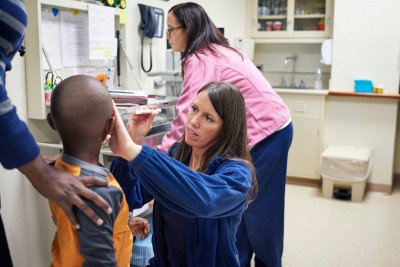
We have performed more than 15,000 examinations for retinoblastoma over the past 100 years.
When there is a family history of retinoblastoma, a child is most likely to develop the disease within 28 months of birth. Newborn babies should have a dilated eye exam by a pediatric ophthalmologist (eye doctor) in the nursery.
When there is no family history, it is frequently the parents who notice the main symptoms of retinoblastoma: a white pupil reflex instead of a normal black pupil or red reflex, or a crossed eye. Discovering one of these signs leads the parents to bring their child in for an exam.
Unlike other types of cancer, retinoblastoma is rarely diagnosed with a tissue sample. Although a sample can aid diagnosis, there is concern about spreading the cancer when taking out the tissue. It is very important that an experienced ophthalmic oncologist confirm the diagnosis, as there are other eye conditions that look like retinoblastoma but aren’t. At Memorial Sloan Kettering, our ophthalmic oncologists have performed more than 15,000 examinations for retinoblastoma over the past 100 years.
Ophthalmic Exam
An ophthalmic examination is the best and most thorough way to diagnose your child. These exams are best done under general anesthesia. Some very young and older patients can be examined without general anesthesia. If you have any questions about whether your child should have anesthesia, ask your ophthalmologist, anesthesiologist, or nurse. For children receiving anesthesia, parents are allowed and encouraged to be with their children in the procedure room until the child is safely asleep.
During the exam, the ophthalmologist looks for tumors on the retina with a lighted tool that magnifies what the doctor sees. A metal clip is placed around the eyelids to help keep the child’s eye open.
A cotton swab or a special tool called a metal scleral indenter, which looks like a pen with a flattened tip, moves the most forward portions of the retina into view. Because children are typically under anesthesia and the eye is numbed, they have little or no discomfort.
During the exam, drawings are done and photographs are taken to evaluate the child’s eye. These kinds of drawings are familiar to ophthalmologists worldwide. Future exams will be based on these drawings and photos, and new drawings and photos may be made at each follow-up visit.
MRI
If your child is diagnosed with retinoblastoma, our experts will perform an MRI of the head. This is done to confirm the diagnosis and to check if the tumors have spread to the brain. Sometimes this happens when retinoblastoma is diagnosed at an advanced stage. If this is the case, we’ll refer you to a pediatric oncologist for additional care. MRIs are usually repeated each year after a diagnosis.
Ultrasound
Ultrasound, which uses sound waves to outline what’s inside the eye, can confirm if retinoblastoma tumors are present and can determine their thickness or height. Black-and-white photographs of the ultrasound images may be taken.
Electroretinography
It is hard to figure out how well very small children can see. Your child’s doctor may do an electroretinogram, which measures the electrical activity of the retina. This test can stand in for vision tests.
When a child is diagnosed with retinoblastoma, an MRI of the eyes, eye sockets, and brain is done to confirm the diagnosis and find out if there are any tumors outside the eye.
Testing for Metastatic Retinoblastoma
If a doctor suspects a child has metastatic retinoblastoma, the child will be seen by a pediatric oncologist. The pediatric oncologist determines if there is cancer anywhere else in the child’s body. A physical exam, blood tests, a spinal tap, and a bone marrow tissue sample are performed.
Genetic Testing
Genetic testing can help you find out if your child has inherited a genetic abnormality. Megan Harlan Fleischut and Jennifer Kennedy, our certified genetic counselors dedicated to retinoblastoma, are available to consult with families and discuss testing options. We can test using just a blood sample. If the patient has the inherited genetic abnormality, other members of the family may be screened or observed for the disease.
The most common situation is that neither parent has the gene for retinoblastoma but they have a child born with the disease. If the parents are genetically normal, the chance of another child having retinoblastoma is one in 15,000 to 20,000.



